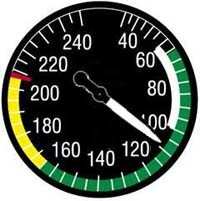Aero-Tips!
A good pilot is always learning -- how many times have you heard
this old standard throughout your flying career? There is no truer
statement in all of flying (well, with the possible exception of
"there are no old, bold pilots.")

Aero-News has called upon the expertise of Thomas P. Turner,
master CFI and all-around-good-guy, to bring our readers -- and us
-- daily tips to improve our skills as aviators. Some of them, you
may have heard before... but for each of us, there will also be
something we might never have considered before, or something that
didn't "stick" the way it should have the first time we memorized
it for the practical test.
Look for our daily Aero-Tips segments, coming each day to you
through the Aero-News Network.
Aero-Tips 09.22.06
Imagine launching into poor visibility or night conditions with
anything less than optimal flight instruments. Or losing use of a
primary flight instrument in instrument or dark night conditions
and only then learn that one of your supporting instruments is
broken. It's vital before taking off into reduced visibility of any
sort (including nighttime) to verify the proper operation of your
flight instruments.
 Airspeed indicator
(ASI). Starting at the upper left of a standard instrument
panel layout, before takeoff check that the indicated airspeed
makes sense. Most pilots will tell you to check that the ASI reads
zero, and in most cases that's right. But as I write this the wind
outside is blowing at about 40 knots (hey, it's Kansas). If I was
in an airplane pointed into the wind on the ramp I'd expect the
airspeed indicator to indicate around 40 knots. If it didn't, I'd
suspect something was wrong.
Airspeed indicator
(ASI). Starting at the upper left of a standard instrument
panel layout, before takeoff check that the indicated airspeed
makes sense. Most pilots will tell you to check that the ASI reads
zero, and in most cases that's right. But as I write this the wind
outside is blowing at about 40 knots (hey, it's Kansas). If I was
in an airplane pointed into the wind on the ramp I'd expect the
airspeed indicator to indicate around 40 knots. If it didn't, I'd
suspect something was wrong.
Attitude indicator (or Artificial Horizon, or with a
flight director an Attitude Director Indicator). Check the
AI(AH/ADI) to see it is spun up and indicates wings-level flight.
It should not indicate a bank of more than five degrees during taxi
turns (it really shouldn't show a bank at all on the ground). Any
flags on the instrument (that indicate failure) should be retracted
out of sight. Now's a good time to check the vacuum/instrument air
pressure gauge and any other pneumatic indicators for proper
values, too.
Altimeter. With the current altimeter setting
dialed in, the altimeter should indicate +75 feet of the published
field elevation. You may have to take airport slope into account;
in extreme cases of difference in elevation at points on the
airport, you'll find information in the Airport Facilities
Directory.
Magnetic compass. Continuing a "flow check"
across the top of most panels, check that the magnetic compass is
full of fluid, that it moves freely during taxi turns, and that it
indicates known headings. The reading may be affected by metal near
the compass (for instance, a handheld GPS on the glareshield), or
when unusual electrical loads are turned on (like windshield
anti-ice or air conditioners).
Vertical speed indicator (VSI). Not required
for IFR flight, the VSI is nonetheless a vital aid in attitude
flying. Note the "level flight" indication on the VSI while you are
on the ground (it may not be the "zero" point). Use the noted
indication as the level setting in flight, and adjust your reading
of climbs and descents on the gauge accordingly.
Heading indicator (or Directional Gyro, or Horizontal
Situation Indicator). Check that the HI/DG/HSI turns
freely, indicates known headings and (subject to compass errors)
generally agrees with the magnetic compass. It should not precess
noticeably during the typical time from startup/setting to takeoff.
Any instrument flags should be retracted; check the power source
(vacuum/instrument air/electric as appropriate) and, for HSIs,
confirm the salving system is turned on.
Turn coordinator/Turn and Bank. Check that the
gyro is spinning and there are no flags (sometimes there's a red
indicator in a tiny window on the instrument's face). Check that,
during taxi turns, the device shows a rate of turn in the same
direction, and the slip/skid ball swings to the direction opposite
the turn.
Glass cockpit pilots need to check all
indicators and power sources with a similar flow check. Don't
forget to include those critical back-up "steam gauges" in your
preflight checks as well-they're your only backup to a single-point
Attitude and Heading Reference System (AHRS) failure, and they'll
do you no good in an emergency if they're not accurate.
Aero-tip of the day: Get in the habit of
quickly checking flight instruments before every takeoff, so it'll
be second nature when you prepare for a low-visibility flight.
 Airborne 05.10.24: Icon Auction, Drunk MedEvac Pilot, Bell ALFA
Airborne 05.10.24: Icon Auction, Drunk MedEvac Pilot, Bell ALFA ANN's Daily Aero-Term (05.13.24): ILS PRM Approach
ANN's Daily Aero-Term (05.13.24): ILS PRM Approach ANN's Daily Aero-Linx (05.13.24)
ANN's Daily Aero-Linx (05.13.24) Airborne-NextGen 05.07.24: AI-Piloted F-16, AgEagle, 1st 2 WorldView Sats
Airborne-NextGen 05.07.24: AI-Piloted F-16, AgEagle, 1st 2 WorldView Sats Airborne 05.08.24: Denali Update, Dad-Daughter Gyro, Lake SAIB
Airborne 05.08.24: Denali Update, Dad-Daughter Gyro, Lake SAIB




